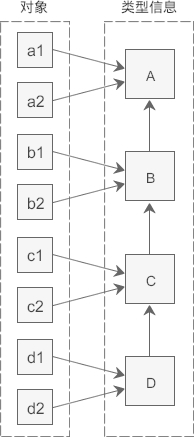( ),而( )在代码中随处可见,所以也不利于使用文本检索工具(例如 Windows 下的 Ctrl+F、Linux 下的 grep 命令、Mac 下的 Command+F)定位关键代码。| 关键字 | 说明 |
|---|---|
| static_cast | 用于良性转换,一般不会导致意外发生,风险很低。 |
| const_cast | 用于 const 与非 const、volatile 与非 volatile 之间的转换。 |
| reinterpret_cast | 高度危险的转换,这种转换仅仅是对二进制位的重新解释,不会借助已有的转换规则对数据进行调整,但是可以实现最灵活的 C++ 类型转换。 |
| dynamic_cast | 借助 RTTI,用于类型安全的向下转型(Downcasting)。 |
xxx_cast<newType>(data)
newType 是要转换成的新类型,data 是被转换的数据。例如,老式的C风格的 double 转 int 的写法为:double scores = 95.5; int n = (int)scores;C++ 新风格的写法为:
double scores = 95.5; int n = static_cast<int>(scores);
void *转int *、char *转void *等;int *转double *、Student *转int *等。不同类型的数据存储格式不一样,长度也不一样,用 A 类型的指针指向 B 类型的数据后,会按照 A 类型的方式来处理数据:如果是读取操作,可能会得到一堆没有意义的值;如果是写入操作,可能会使 B 类型的数据遭到破坏,当再次以 B 类型的方式读取数据时会得到一堆没有意义的值。#include <iostream> #include <cstdlib> using namespace std; class Complex{ public: Complex(double real = 0.0, double imag = 0.0): m_real(real), m_imag(imag){ } public: operator double() const { return m_real; } //类型转换函数 private: double m_real; double m_imag; }; int main(){ //下面是正确的用法 int m = 100; Complex c(12.5, 23.8); long n = static_cast<long>(m); //宽转换,没有信息丢失 char ch = static_cast<char>(m); //窄转换,可能会丢失信息 int *p1 = static_cast<int*>( malloc(10 * sizeof(int)) ); //将void指针转换为具体类型指针 void *p2 = static_cast<void*>(p1); //将具体类型指针,转换为void指针 double real= static_cast<double>(c); //调用类型转换函数 //下面的用法是错误的 float *p3 = static_cast<float*>(p1); //不能在两个具体类型的指针之间进行转换 p3 = static_cast<float*>(0X2DF9); //不能将整数转换为指针类型 return 0; }
#include <iostream>
using namespace std;
int main(){
const int n = 100;
int *p = const_cast<int*>(&n);
*p = 234;
cout<<"n = "<<n<<endl;
cout<<"*p = "<<*p<<endl;
return 0;
}
运行结果:&n用来获取 n 的地址,它的类型为const int *,必须使用 const_cast 转换为int *类型后才能赋值给 p。由于 p 指向了 n,并且 n 占用的是栈内存,有写入权限,所以可以通过 p 修改 n 的值。#define,是一个值替换的过程,代码中所有使用 n 的地方在编译期间就被替换成了 100。换句话说,第 8 行代码被修改成了下面的形式:
cout<<"n = "<<100<<endl;
这样以来,即使程序在运行期间修改 n 的值,也不会影响 cout 语句了。更多关于 const 的内容请猛击《C++中的const又玩出了新花样》。
#include <iostream>
using namespace std;
class A{
public:
A(int a = 0, int b = 0): m_a(a), m_b(b){}
private:
int m_a;
int m_b;
};
int main(){
//将 char* 转换为 float*
char str[]="http://task.lmcjl.com";
float *p1 = reinterpret_cast<float*>(str);
cout<<*p1<<endl;
//将 int 转换为 int*
int *p = reinterpret_cast<int*>(100);
//将 A* 转换为 int*
p = reinterpret_cast<int*>(new A(25, 96));
cout<<*p<<endl;
return 0;
}
运行结果:A*转换为int*,使用指针直接访问 private 成员刺穿了一个类的封装性,更好的办法是让类提供 get/set 函数,间接地访问成员变量。
dynamic_cast <newType> (expression)
newType 和 expression 必须同时是指针类型或者引用类型。换句话说,dynamic_cast 只能转换指针类型和引用类型,其它类型(int、double、数组、类、结构体等)都不行。std::bad_cast异常。
#include <iostream>
#include <iomanip>
using namespace std;
class Base{
public:
Base(int a = 0): m_a(a){ }
int get_a() const{ return m_a; }
virtual void func() const { }
protected:
int m_a;
};
class Derived: public Base{
public:
Derived(int a = 0, int b = 0): Base(a), m_b(b){ }
int get_b() const { return m_b; }
private:
int m_b;
};
int main(){
//情况①
Derived *pd1 = new Derived(35, 78);
Base *pb1 = dynamic_cast<Derived*>(pd1);
cout<<"pd1 = "<<pd1<<", pb1 = "<<pb1<<endl;
cout<<pb1->get_a()<<endl;
pb1->func();
//情况②
int n = 100;
Derived *pd2 = reinterpret_cast<Derived*>(&n);
Base *pb2 = dynamic_cast<Base*>(pd2);
cout<<"pd2 = "<<pd2<<", pb2 = "<<pb2<<endl;
cout<<pb2->get_a()<<endl; //输出一个垃圾值
pb2->func(); //内存错误
return 0;
}
情况①是正确的,没有任何问题。对于情况②,pd 指向的是整型变量 n,并没有指向一个 Derived 类的对象,在使用 dynamic_cast 进行类型转换时也没有检查这一点,而是将 pd 的值直接赋给了 pb(这里并不需要调整偏移量),最终导致 pb 也指向了 n。因为 pb 指向的不是一个对象,所以get_a()得不到 m_a 的值(实际上得到的是一个垃圾值),pb2->func()也得不到 func() 函数的正确地址。
#include <iostream>
using namespace std;
class A{
public:
virtual void func() const { cout<<"Class A"<<endl; }
private:
int m_a;
};
class B: public A{
public:
virtual void func() const { cout<<"Class B"<<endl; }
private:
int m_b;
};
class C: public B{
public:
virtual void func() const { cout<<"Class C"<<endl; }
private:
int m_c;
};
class D: public C{
public:
virtual void func() const { cout<<"Class D"<<endl; }
private:
int m_d;
};
int main(){
A *pa = new A();
B *pb;
C *pc;
//情况①
pb = dynamic_cast<B*>(pa); //向下转型失败
if(pb == NULL){
cout<<"Downcasting failed: A* to B*"<<endl;
}else{
cout<<"Downcasting successfully: A* to B*"<<endl;
pb -> func();
}
pc = dynamic_cast<C*>(pa); //向下转型失败
if(pc == NULL){
cout<<"Downcasting failed: A* to C*"<<endl;
}else{
cout<<"Downcasting successfully: A* to C*"<<endl;
pc -> func();
}
cout<<"-------------------------"<<endl;
//情况②
pa = new D(); //向上转型都是允许的
pb = dynamic_cast<B*>(pa); //向下转型成功
if(pb == NULL){
cout<<"Downcasting failed: A* to B*"<<endl;
}else{
cout<<"Downcasting successfully: A* to B*"<<endl;
pb -> func();
}
pc = dynamic_cast<C*>(pa); //向下转型成功
if(pc == NULL){
cout<<"Downcasting failed: A* to C*"<<endl;
}else{
cout<<"Downcasting successfully: A* to C*"<<endl;
pc -> func();
}
return 0;
}
运行结果:A*类型的指针,当 pa 指向 A 类型的对象时,向下转型失败,pa 不能转换为B*或C*类型。当 pa 指向 D 类型的对象时,向下转型成功,pa 可以转换为B*或C*类型。同样都是向下转型,为什么 pa 指向的对象不同,转换的结果就大相径庭呢?

本文链接:http://task.lmcjl.com/news/8769.html